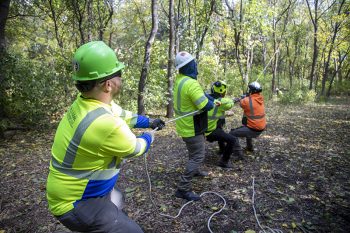Tree crews sharpen their skills at OPPD Arboretum

Tony Johnson swayed back and forth in the old maple tree, dangling from a harness 30 feet above the ground with a chainsaw burbling in his hands.
Slowly, methodically, he braced himself against a branch and studied the gnarled mess of limbs tangled in power lines just over his head. Then he set to work. The chainsaw howled, chewing through timber and spraying wood shavings into the chilly fall breeze. Branches fluttered, cartwheeled and thumped to the ground.
It was a typical job for Johnson, a 10-year arborist with Asplundh Tree in Omaha, and one that shows the dangers crews can face when homeowners plant the wrong trees in the wrong place. But Johnson and his co-workers weren’t on a normal call. All of their work was part of a training exercise at the OPPD Arboretum, with dummy power lines deliberately set over the silver maple to simulate a real-world challenge.

“It’s a big hazard,” Johnson said later, gazing up at the freshly pruned tree. “This one was borderline extreme, but we see a lot of this.”
Trees that grow into power lines are a common and avoidable problem in OPPD’s service area. They create risks for homeowners, their neighbors and the crews who put themselves on the line to make sure branches don’t cause a power outage or a fire.
Trimming trees increases safety
At the same time, some homeowners get frustrated when crews arrive to trim back their trees. The crews tasked with trimming trees, hired by OPPD, cut branches in ways that are designed to keep trees alive and help them heal, while ensuring that they align with the utility’s line clearance guidelines.
Sometimes, that means removing a large section.
“This is the reason we preach ‘Right tree, right place,’” said Aaron Holloway, a senior utility forester at OPPD, who used to climb trees himself as a worker for Asplundh. If a tree is in the way, “we have to come in and trim it so your house doesn’t burn down, so your kids don’t go back there and get electrocuted.”

Holloway stressed that homeowners shouldn’t try to do the job themselves. Climbing a tree safely requires special training, ropes, harnesses, locking carabiners and helmets, among other safety gear. Workers typically spend years clearing brush on the ground, feeding limbs into a grinder and performing other tasks before they’re allowed to strap into a harness.
“Tree trimming is dangerous enough, but then you throw in live power lines and that really complicates things,” said OPPD Forester Mike Norris.
That lesson was clear for the crews who trained at the OPPD Arboretum, a leafy patch of land with trails that wind through wooded areas and past de-powered electric lines and poles.
A focus on education
Norris, who oversees tree care at the arboretum, said OPPD provides the grounds to help work crews practice and reinforce safety protocols. It’s also part of the utility’s commitment to proper forest management, which has led to recognition from the Arbor Day Foundation. In April, the foundation named OPPD a “Tree Line USA Utility” for the 22nd year, recognizing utilities that use best practices to protect and cultivate urban trees.

The Arboretum, just west of Interstate 680 in Omaha at 108th and Blondo streets, also serves as a public education center. Customers can learn the best tree options to plant in the vicinity of power lines. Silver maples, black walnut and oaks are a no-no because they grow tall and wide. Serviceberry, redbud and hawthorn trees are better, because they’re shorter and much less likely to interfere with lines.
The Arboretum opened in 2004 as a venue where visitors can walk their dogs, take senior photos or figure out which tree to plant in their yards. Families use it for weddings. A small prairie welcomes butterflies and bees. At the top of a hill, hikers can look down at an OPPD substation next door and learn a little about transmission lines.
The trees are pretty, but also have the important job of showing people how and where to plant around power lines and equipment.
“We built all of this with education in mind,” said John Buckley, OPPD’s director of work management. “This is what we have to do when trees get too big so that we can keep people safe and the power reliable.”

Grant Schulte joined OPPD as a content generalist in 2022. He is a former reporter for The Associated Press, where he covered the Nebraska Legislature, state politics and other news for a global audience. He is a graduate of the University of Iowa and a proud Hawkeye. In his free time he enjoys running, reading, spending time with his wife, and all things aviation.
View all posts by Grant Schulte >







